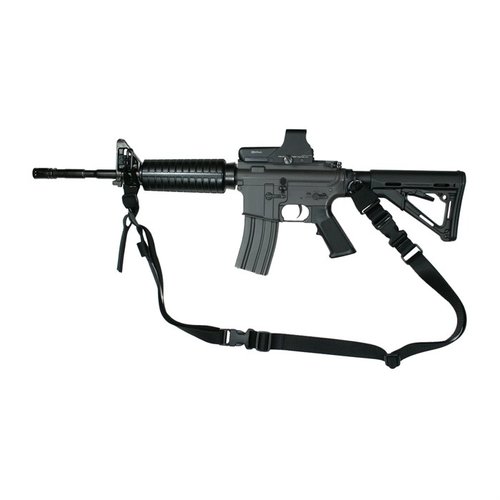A sling is like a holster for your rifle. It is a must have item on a battle carbine.

Single Point Sling
Single Point slings are particularly suited for people who intend to use the weapon and need it “at the ready”. The very nature of the single point is that it allows the user the greatest freedom in maneuvering and manipulating the weapon, while still giving the user weapon retention. Allows the user to shoot from either shoulder with the sling on (like when shooting from cover) and good for PSD, getting in and out of vehicles, dynamic entry, MOUT, etc…
The downside is that the single point will dangle from the user if he doesn’t keep both hands on it, i.e. if you transition to a sidearm, need to climb something, slapping cuffs on someone or if you are carrying wounded. You can still transition to a sidearm and all, but you will need to move the weapon down and away from your front and if you are running or climbing, etc… the rifle can bang against the user. If you go to your knees without your hands on the weapon, the front end can smack the ground (common problem for medics who have to treat wounded).

Transition to sidearm with a single point
Some guys even complain that if they simply let go of the rifle it will hit them in the nuts… which of course is not a recommended way to handle a weapon with a single point sling. If you are having this problem you are not using this sling properly. If that bothers you, learn to use it properly, or use a different sling style (2-point, 3-point).
Another downside is that the single point slings usually require you to purchase and install a mount specifically mounted near the rear of the receiver.
The truth about single point slings is this, if you don’t think you need one, you probably don’t. Most people don’t understand how to use them and what their real benefits are, and even some people who do understand that do not prefer the single point in general. For those who know and understand the benefits they offer, and are in need of those benefits, there is really no good substitute.
2-Points are good all-purpose slings. Mostly just a carry strap. But it is a more secure method of keeping the weapon on you.
The problem with the standard 2-point is that once you set the length, it is stuck at that length and usually takes a minute or two to take off the sling and re-adjust the length.
With a 2-Point Quick Adjust, you can adjust the length of the sling in a second while you have the sling on, and can still carry it “at the ready”.
A 2-Point Quick Adjust is really the best all-purpose sling. These, when properly set up, provide the user with all of the advantages of the other slings, and none of the disadvantages.

Keep it tightened when not in use to prevent snagging.

Loosen in order to wear.

The 2-Point Quick Adjust is secure, yet…

…quickly and easily deployed.

Loosen sling a little more…

…and you can shoot from your support side.

Use Tightening Strap to take up any excess slack.

Go hands free!
To best utilize a 2-Point Quick Adjust you will want a side mount sling swivel in the front of the weapon.

3-Point Sling
It is a bit complicated though for many and makes the weapon almost too secure for all-purpose use. So much so that shooting from a weak shoulder (Around cover, or if you get injured on your strong side) is impossible with the sling on, also can hang up on certain gear depending on what you are wearing.
Three-Points can also interfere with controls on the AR15 or ejection of the case for left handers.
Sling Mounting Points

Daniel Defense RH Burnsed Loop

Side Mount Sling Swivel – Mounts to barrel under the FSB
